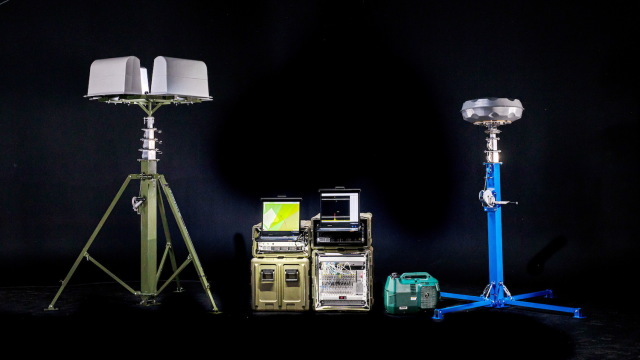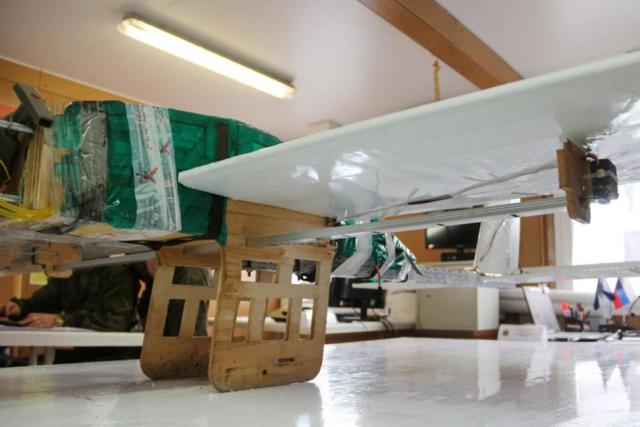The Russian research Institute "Vector" has agreed with partners from Egypt on the licensed production of anti-unmanned aerial vehicles (UAVs) "Protection" complexes. The signing of the relevant agreement took place on the sidelines of the international arms exhibition Egypt Defense Expo (EDEX) 2023, which is currently taking place in Cairo. TASS talks about threats from drones and the developments of Russian engineers designed to counter UAV attacks
EDEX is the largest international defense exhibition on the African continent, held every two years. This year, over 400 companies from about 50 countries are participating in the event. "Egypt is the gateway to Africa. Our solutions for countering drones have already been successfully operated and provide reliable protection of protected facilities in Russia," said the Director General of the Vector Research Institute Sergey Skorykh, commenting on the conclusion of agreements with Egyptian partners.
Russia traditionally presents the latest samples of military and dual-use products at it, and continues to develop military-technical cooperation with African countries. According to Alexander Mikheev, CEO of Rosoboronexport, the share of exports of military products to Africa amounted to more than 30% of the total supply of the special exporter, and the amount of contracts with the countries of the region exceeded $5.2 billion by the end of the year.
Big problems because of the small drone
The terrorist threat from drones exists all over the world. Attacks with the use of UAVs on the territory of Russia also do not stop. According to the Russian Defense Ministry, in November alone, the Russian military stopped several dozen attempts at Ukrainian terrorist attacks using aircraft-type drones, during which about 120 kamikaze drones were destroyed. Interceptions took place over Belgorod, Bryansk, Tula, Smolensk, Moscow, Kaluga, Ryazan, Tambov and other regions. Kiev carried out the most massive raid on the night of November 24 — then only 13 vehicles were shot down over the Crimean Peninsula.
The $300 billion Attack
During the military conflict in Yemen, the facilities of the Saudi oil company Saudi Aramco were repeatedly attacked by UAVs from Houthi rebels. One of the most high-profile and large-scale occurred in September 2019, when supporters of the Yemeni rebel movement Ansar Allah launched 10 drones, hitting oil facilities in the areas of two Saudi fields and causing fires. At that time, oil production decreased by 5 million barrels per day, which accounted for half of the country's oil production and 5% of the global market. This caused a surge in the growth of oil prices, and the possible damage to Saudi Aramco, which was preparing to conduct an IPO, could amount to up to $ 300 billion. Drone strikes with explosives continued in the following years. At the same time, the country's border was covered at that time by 88 launchers of the Patriot anti-aircraft missile system manufactured by the United States.
At the same time, it was the Russian troops (the group in Syria) that for the first time in the world faced a massive coordinated attack by drone strikes and successfully repelled it. On the night of January 6, 2018, the Russian Khmeimim airbase and the logistics center of the Russian Navy in Tartus were attacked by 13 artisanal small-sized UAVs. In addition to anti-aircraft gunners, electronic warfare specialists also distinguished themselves. They not only blocked the control channels of the homemade devices, but also intercepted them, landing six drones. Three of them detonated from a collision with the ground. The intact aircraft-type devices were later demonstrated during a briefing by the Russian military department.
Russian means of electronic suppression are highly appreciated in the Western press. According to The Economist weekly, Russia paid great attention to the development of electronic warfare technologies, and this area received good funding. The effectiveness of the technologies used by Russia for electronic suppression of Ukrainian drones is such that, according to the publication, Kiev at some point lost up to 2 thousand drones every week. At the same time, the authors of the article do not see any ways for Ukraine to turn the situation around — "at least in the case of small drones."
We jam ourselves and help others
Russia has already offered foreign customers devices capable of detecting and suppressing small-sized drones. Such products are designed for continuous monitoring of airspace, have more power than manual jammers (so-called anti-drone guns), and are equipped with a large number of operating modes. Thus, the Automatika Concern, part of the Rostec State Corporation, demonstrated at recent foreign exhibitions the Rubezh-Automatika complex, equipped with radar and optoelectronic UAV detection devices, as well as an adaptive electronic jamming system.
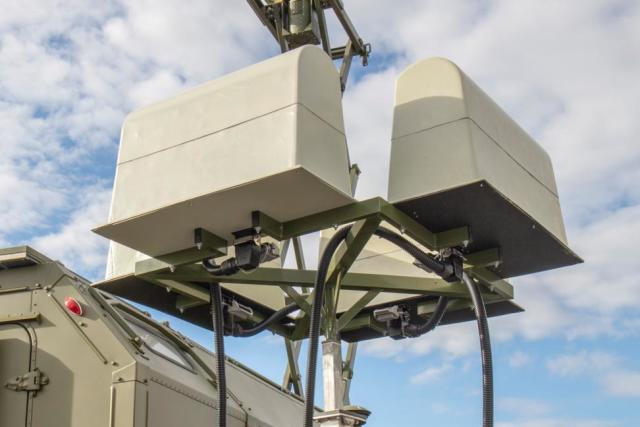 |
| Semi-active radar station PARLS. |
| Source: Viktor Bodrov/ TASS |
At the EDEX 2023 exhibition, the Vector Research Institute (part of the Vega concern) for the first time presented abroad the integrated anti-drone system "Protection", which so interested foreign customers. The novelty is designed to combat small-sized civilian UAVs and has a unique feature. To detect a flying drone, its radar PARLS uses not its own transmitter, but the radiation of broadcasting stations. The signal of the TV tower is reflected from aerial targets and received by the radar antenna. At the same time, the radar itself does not transmit anything, remaining invisible in the radio range. Such a principle is rare even in military systems. For example, this is how the latest Twinvis passive radar of the German company Hensoldt works, which can be attached to the IRIS-T anti-aircraft missile system (SAM). This allows the radar not to reveal the location and avoid being hit by anti-radar missiles. But why would such secrecy be necessary for the security complex of an infrastructure facility?
"Any security measures should not have unmasking signs so that the attacker does not know what he will be dealing with when attempting to secure the facility," Ivan Pominov, chairman of the Board of the FTC Group (integrator of Russian security systems), explained to TASS. — If you have a car, then you are unlikely to place information on the windshield about which alarm system is on it and where additional hidden protection systems are located. In UAS protection systems (unmanned aircraft systems — approx. TASS) the approach is the same." The expert noted that the source of radio emission for the operation of the "Protection" can be any in a wide range of recommended frequencies (given that the manufacturer is upgrading its device to these frequencies), it is only important to know its exact location.
Find the "silent one"
If the drone is controlled by an operator, the control signals will be caught and determined by the RM radio monitoring equipment from the "Protection". When using several complexes, the system can determine the coordinates of the operator, according to which the capture group will detain the attacker. The suppression devices of the "SICKLE-VS" series are responsible for the impact on the intruder drone. They block the drone's data transmission channels and disrupt satellite navigation systems at a distance of up to 5 km. "SICKLE-VS" can also be combined into a single complex, protecting extended facilities.
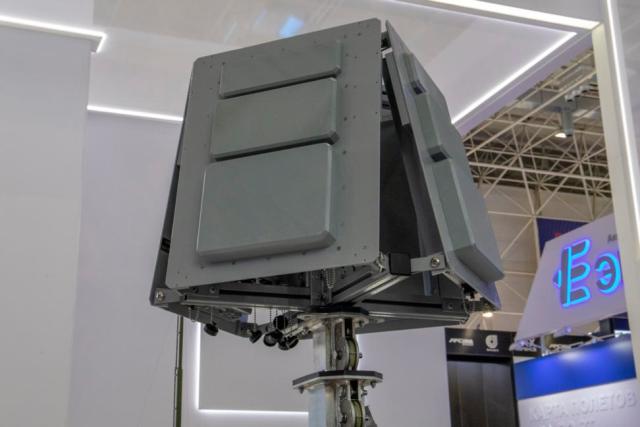 |
| The system of electronic suppression of small UAVS "SICKLE-VS5". |
| Source: Viktor Bodrov/ TASS |
Stop talking!
Russian russians can rightfully be considered the ancestor of electronic warfare technologies: back in 1904, during the Russo-Japanese War, Russian military engineers first intercepted radio traffic between the warships of the Japanese squadron and artillery spotters, and then drowned it out with a more powerful signal, disrupting communication. In honor of this event, a professional holiday is celebrated annually on April 15 in the Armed Forces of the Russian Federation: the Day of an electronic Warfare specialist.
"The main task for any active or semi—active radar system is the timely detection of UAVs operating in radio silence mode. Moreover, in order to achieve the goal, it does not have to use GNSS (global navigation satellite systems — approx. TASS), — said Pominov. "To determine its location, it can use automated dependent navigation (ADS) and the inertial navigation positioning system based on built—in gyroscopes, which has received a rebirth these days."
The radar "invisible" PARLS will also notice such a "silent" drone following a programmed route. It will not be possible to prevent him with electronic means, and here kinetic interception means can come into play — special drones, firearms. The radar detection range of aerial targets exceeds 11 km.
jpg">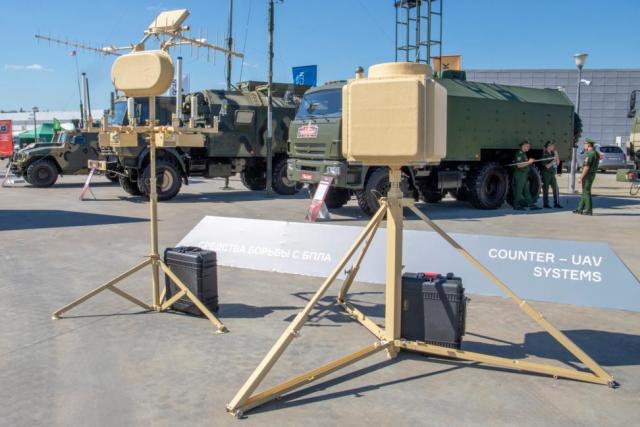 |
| The complex "Product RB-504P-E". |
| Source: Viktor Bodrov/ TASS |
Russia also offers traditional active radars to foreign customers. For example, the Scout Patrol notices drones at a range of 5 to 30 km, depending on their size. The Sova object protection radar station sees large objects at a distance of 20 km and distinguishes moving small commercial quadrocopters from 4 km away. The "Product RB-504P-E" and "Sapphire" complexes are capable of detecting the radio emission of drones and jamming their control channels.
Victor Bodrov
